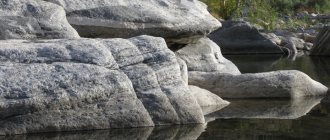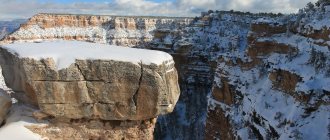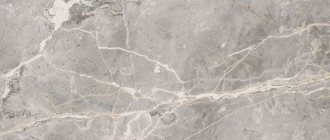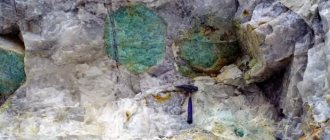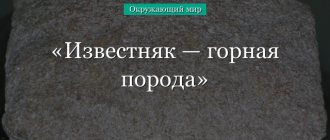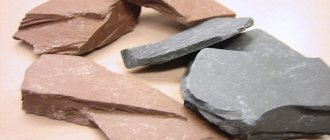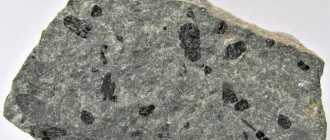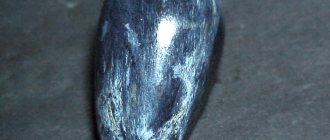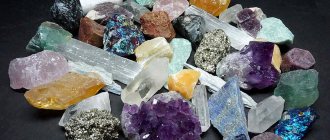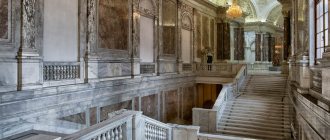| Category | Igneous rocks |
| Title in English | Rhyolite |
| Formula | SiO2, TiO2, Al2O3, Fe2O3, FeO, MgO, CaO, Na2O, K2O |
| Group | Quartz group |
| Color | White, Yellow, Pink |
| Stroke color | White |
| Shine | Oily, Glassy, Resinous |
| Transparency | Transparent |
| singonia | Monoclinic |
| Hardness | 5 — 6 |
| Cleavage | Perfect |
| Density, g/cm³ | 2,14 — 2,59 |
| Kink | Conchoidal |
| origin of name | Rhyolite is a volcanic rock, so in theory it is a liquid stone. Geologist and part-time baron, Ferdinand von Richthofen described the stone, calling it rhyolite, which translated from Greek means ρεω - flow and λίθος - stone. At the same time, scientist Justus Root studied magmatic outpourings on the Italian island of Lipari, where he found this mineral. Only the scientist did not know about Richthofen’s work, so he gave another name to the mineral - Liparite. By the way, these days, the designation “liparite” is no longer used. |
Rhyolite is an igneous volcanic rock and is similar in composition to granite. This mineral is characterized by a glassy structure interspersed with quartz, plagioclase, and sanidine. The stone is also known by the obsolete name "liparite", as it was first discovered in the Aeolian Islands. Scientists later determined that rhyolite occurs in areas of volcanic activity across the planet in the form of lava flows, volcanic domes, or ash accumulations.
Rhyolite deposits
The material for the formation of rhyolite is not always lava, but it must be the products of volcanic activity.
For example, heavy magma, saturated with gases, comes to the surface and stops at the moment of formation of a volcanic dome, the main component of which will be rhyolite. A pyroclastic flow can also deposit a thick layer of volcanic ash on the ground, cake and set to form rhyolites. — Advertising —
Today, rhyolite is mined in all places where there are volcanoes: in the Caucasus, in the Amur region and Kamchatka in Russia, in Ukraine, in Kazakhstan, in European countries and in the USA. At the same time, gems differ in external characteristics depending on their origin.
Price
In Russian online stores you can buy a variety of products, collectible and handicraft materials (price/RUB):
- box (10.7x8.1x5.2 cm; Madagascar) – 12,600;
- polished cut (12.5x7x4 cm; Kazakhstan) – 2,500;
- tumbling (3-6.5 cm; Kazakhstan) – 300 – 550;
- beads (bead: 1.5x1.2 cm, length 47 cm; Madagascar) – 1,550.
However, the range is limited, jewelry and other products are made by hand, which increases the price.
History of rhyolite
Geologist and geographer Baron Ferdinand von Richthofen in the mid-19th century formulated a description of a “liquid stone” called rhyolite.
Around the same time, a scientist from Germany, Justus Roth, was studying magmatic outpourings on the island of Lipari and discovered acidic rocks that form from lava. According to the location of the find, the mineralogist named the stone liparite. When scientists later compared both minerals, it turned out that they were absolutely identical. Now the name “liparite” is outdated, and it is recommended to call silicate rock of volcanic origin rhyolite.
Magical influence
The magic stone Liparite brings good luck to lovers. It will fill the relationship with romance and make the union strong. The energy it attracts helps to find mutual understanding. Conflicts and quarrels will no longer take energy and interfere. The magic stone will help to distinguish the essential from the unimportant.
Liparite has a positive effect on the nervous system, strengthens the structure of the biofield, and fills it with energy. Negative influences from outside cannot penetrate such protection. Mental anguish and experiences will not become a fatal wound; they cannot lead to the loss of too much psychic energy. Negative feelings will no longer dominate others, even if a person is in a very difficult life situation. This will help you find a way out, a solution, and see them. A magical gem will contribute to their appearance.
Rhyolite eliminates nervous tension, activates the self-healing mechanism, and strengthens the immune system. It is able to stop pathological processes in the body, attract the energy needed for recovery, the energy of help and creation. People of different zodiac signs and different genders can wear it. This is a universal magic stone.
Physicochemical characteristics of rhyolite
The chemical composition of rhyolite is quite complex and is represented by a whole complex of oxides of silicon, titanium, aluminum, iron, magnesium, calcium, sodium, and potassium.
Its main component is silica; it also contains feldspar and quartz. Among the impurities are pyroxenes, plagioclases, jasper, and biotite. — Advertising —
At the fracture, the mineral is glassy or granular. With a Mohs hardness of 5, rhyolite is generally a brittle stone, unlike granites, which it resembles in chemical composition.
Samples with a high content of silicon oxide are distinguished by light shades or gray color, and a glassy structure. Gases that are released but not evaporated during the formation of rhyolite create the porous structure of the mineral.
Rhyolite with admixtures of various metal oxides looks impressive due to its rich color palette, which includes white, shades of dark green, red, gray, and yellow.
§ 2. Igneous rocks
Processes in education and classification
Igneous (primary) rocks were formed as a result of the eruption and cooling of magma (rock melt located in the bowels of the earth). If the rock was formed according to the scheme shown in Fig. 1a, then it is called deep or intrusive . If the rock occurred as a result of cooling of magma that poured out, according to the diagram in Fig. 1b, then it is called outpoured or effusive .
In addition to these two groups of rocks, which are massive, when lava was ejected from volcanoes in the form of splashes and splashes, loose volcanoclastic rocks were formed: volcanic ash and sand.
The classification of igneous rocks, the processes during their formation and the main representatives are shown in Fig. 2.
Mineralogical composition of igneous rocks
All the main rock-forming minerals of igneous rocks can be divided into four groups: 1) quartz, 2) feldspars, 3) micas and 4) dark-colored. The latter, in contrast to the almost colorless quartz and feldspars, are highly colored. A comparison of minerals of igneous rocks is given in table. 1.
Quartz . In rocks, quartz (crystalline silica - SiO2) is predominantly present in the form of ordinary quartz - opaque or only slightly translucent dense grains, having a glassy sheen and painted in a variety of colors.
It is very typical for quartz that acids do not affect it, with the exception of hydrofluoric acid. Due to its chemical inertness, quartz almost does not weather, as a result of which it is the last remnant of the destruction of the rocks containing it. While other minerals turn into fine destruction products (clay), quartz forms sand.
Feldspars. Feldspars include a group of many minerals that have similar physical and chemical properties. All minerals of this group are characterized by light shades of various colors. They differ from quartz in their lower hardness (6 on the Mohs scale) and their inherent perfect cleavage.
Feldspars are divided into two groups: 1) orthoclase , which in Greek means straight-cut, and 2) plagioclase , which means obliquely split.
In orthoclase, the cleavage planes form a right angle, while in plagioclase they form a different angle (about 86°).
In terms of chemical composition, orthoclase is a potassium aluminosilicate, and plagioclases are a series of minerals, the extreme members of which are albite (sodium aluminosilicate) and anorthite (calcium aluminosilicate). All intermediate terms between albite and anorthite are considered as isomorphic mixtures of both in various proportions.
If we turn to the chemical formulas of plagioclases, it is easy to see that in albite, the formula of which includes 6SiO2, silica should predominate (its content in albite is 68.68%), and vice versa, in anorthite, the formula of which includes only 2SiO2 , silica is already in a subordinate amount (43.16%). Therefore, albite and oligoclase should be classified as acidic plagioclases, and anorthite with adjacent bytownite should be classified as basic. It goes without saying that orthoclase should be considered as an acid feldspar. All feldspars are relatively easily weathered and converted into kaolin, the purest type of clay.
Mica . Of the micas, biotite (black mica) and muscovite (transparent mica) are the most important as rock-forming minerals. Mica differs from other minerals in its very perfect cleavage and low hardness (2-2.5).
If micas are included in a rock in significant quantities, they greatly worsen its mechanical properties; With a high mica content, it also becomes difficult to obtain a good polished surface.
Pyroxenes and amphiboles . Pyroxenes and amphiboles are two groups of similar minerals, each of which has several representatives. For pyroxenes, the most characteristic mineral is augite, and for amphiboles - hornblende, which is why pyroxenes are often called augites, and amphiboles - hornblende.
The best distinguishing feature of these minerals is the angle formed by the cleavage planes; in hornblende it is 124°, and in augite it is 87°. Both amphiboles and pyroxenes differ from other minerals in their very dark color and high density from 3.0 to 3.6 g/cm3. In terms of weathering, they are superior to feldspars.
Consideration of the table. 1 allows us to draw several very important conclusions.
The content of silica in minerals decreases as you move down the table from top to bottom. At the top of the table is quartz, consisting of 100% SiO2, at the bottom are dark-colored minerals with a low, about 35-50%, silica content. Accordingly, the acidity of igneous rocks will depend on the predominance of certain minerals.
Igneous rocks are composed primarily of various silicates and aluminosilicates! In this they differ from sedimentary rocks, in which salts of other acids, primarily carbonic, partly sulfuric, etc., predominate over salts of silicic acid (silicates).
The color of minerals varies from light (at the top of the table) to dark (at the bottom), so that all acidic rocks will be weakly colored, all basic rocks, on the contrary, will be very strongly colored.
Comparison of the density of rock-forming minerals shows us that rocks with a high content of dark components will be characterized by greater weight than acidic, light-colored rocks.
In terms of resistance to weathering, the least desirable in the rock are feldspars, which weather very quickly.
Structure of igneous rocks
The most characteristic of igneous rocks are two structures: granular-crystalline (granite) and porphyry (Fig. 3). The structure of a rock is called granular-crystalline when individual mineral grains are visible to the naked eye and are approximately the same in size.
There is a type of granular-crystalline structure called porphyritic, i.e. similar to porphyry. When a rock contains very large phenocrysts and the surrounding groundmass is granular-crystalline, it resembles a greatly enlarged porphyry structure.
The granular-crystalline structure is characteristic primarily of deep-seated rocks, since it could only be obtained by slow cooling of the rock, when nothing interfered with its complete crystallization. On the contrary, the porphyry structure is inherent in erupted rocks. The presence of phenocrysts in the latter can be explained by the fact that the crystallization of magma began in the bowels of the earth, when the temperature dropped very slowly. After the outpouring of magma onto the surface, the remaining mass solidified, but only with fairly rapid cooling, which is why it turned out to be poorly crystallized.
Even-grained rocks are technically superior to rocks with a porphyritic structure, and technical properties (mechanical strength, resistance to weathering) usually increase with a decrease in the average grain size. Rocks with a porphyry structure are technically less expensive, the more glass they contain. Glassy rocks (for example, pure volcanic glass - obsidian) are very fragile and do not withstand temperature fluctuations well.
Classification of igneous rocks by structure and mineralogical composition
The classification of igneous rocks by structure and mineralogical composition is presented in table. 2.
In the central part, three rows of the table show the main igneous rocks used as building materials. Under each name of deep-seated rocks, two representatives of the erupted rocks are recorded, which are complete analogues of them in mineralogical composition and differ only in structure. The same magma could solidify either at depth or on the surface of the earth. We can read the mineralogical composition of the rocks in the same column of the table immediately above them. For example, about the mineralogical composition of granite and its analogues (quartz porphyry and liparite) we read: there is quartz, orthoclase is present from feldspars, there are few dark-colored minerals. If we follow the table from left to right.
looking at the mineralogical composition, we will see that there is no quartz (the most acidic mineral), except in granite and its analogues, in other rocks. The content of dark-colored minerals (the most basic) increases from granite to gabbro, and in the group of feldspars the representatives change so that in granite and its analogs there is the most acidic representative - orthoclase, and in gabbro, diabase and basalt - the most basic representative of plagioclases - bytownite or anorthitis. As we move from left to right, there is a decrease in SiO2 content, in other words, a decrease in the acidity of the rocks. If we recall what was said regarding minerals (see Table 1), we can also add that the rocks occupying the right side of Table 2 are characterized by a higher density and darker color compared to the rocks located on the left side of the table. In parallel with the increase in the content of dark-colored minerals, the mechanical strength of the rocks increases.
Intrusive (deep) rocks
All intrusive rocks: granite, syenite, diorite and gabbro are very similar to each other in their technical properties. They all have high density, negligible porosity and relatively high mechanical strength.
Granite. The average mineralogical composition of granite is as follows: quartz from 20 to 40%, orthoclase (rarely alkali plagioclase) from 40 to 60%, mica or hornblende (rarely augite) from 5 to 20%.
The structure of granites is predominantly granular-crystalline, otherwise granitic (the name granite comes from the Latin word granum - grain) and in some cases porphyritic. An example of granites with a porphyritic structure is the Finnish rapakivi granite, in which orthoclase phenocrysts the size of a hen's egg or more are found. The red granites of most buildings in St. Petersburg have a porphyry-like structure.
The color of granites is determined by the color of its main component—orthoclase. Depending on the color of the latter, it can be gray, yellowish, reddish, or meat-red.
Technical properties of granite . The density of granite ranges around 2.7 and increases as the amount of dark-colored minerals in the rock increases. Temporary compressive strength for granites (as in general for all natural stones) varies within a very wide range from 80 to 330 MPa. Granites with a fine-grained structure have greater strength. An increase in mica content reduces the mechanical strength of granite; in addition, mica prevents the production of a good polished surface, since it is easily chipped, leaving cracks. On the contrary, an increase in the content of pyroxenes or amphiboles is desirable - the mechanical properties and ability of granites to accept polishing increase.
The weathering resistance of granite is generally quite high. Only some of its representatives, which include the Finnish rapakivi granite (which means rotten stone), which was previously widely used in the construction of St. Petersburg, are destroyed quite quickly. Granite resists abrasion well, which is why it is a valuable material for the manufacture of stair steps, sidewalk slabs, and road pavement. In deep rocks, abrasion resistance increases with increasing amounts of dark-colored minerals.
The processing and finishing of igneous rocks is so expensive (due to the high hardness of the minerals they contain) that they are rarely used in ordinary buildings, but are used primarily in structures that are especially important or of great architectural value.
Application of granite. Granite is used in the form of piece stones for the foundations of expensive buildings, for retaining walls, for the construction of embankments, for external cladding of walls. Paving slabs and steps are often made from it. Larger pieces of granite are used for columns of buildings and monuments. It is used in small pieces for making pavements; for crushing into crushed stone, etc.
Syenite. Differs from granite in the absence of quartz; consists of orthoclase and a dark mineral, most often hornblende.
It is used like granite, differing from the latter in lower hardness, increased viscosity, especially with a significant content of hornblende or augite, and the ability to better accept polishing. It is a valuable material for paving roads and producing crushed stone.
Diorite . It consists mainly of acid plagioclase and hornblende, less commonly biotite and augite; plagioclase constitutes on average 75% of the rock.
According to the change in mineralogical composition, diorite is characterized by a darker color than granite and syenite, a higher density (2.75-3.0) and compressive strength.
Diorites are used as road material (paving stones, crushed stone), in the form of piece stones and as a decorative material (due to their ability to be highly polished).
Gabbro . Significant minerals in gabbro are basic plagioclase (about 50%) and pyroxene, less commonly hornblende. The color is in most cases dark green in various shades. Density 2.8-3.1, compressive strength in fine-grained varieties 200-280 MPa, falling in coarse-grained varieties to 100 MPa. Gabbro is difficult to process, but takes polish well.
Of the decorative varieties of plutonic rocks, labradorite, a coarse-grained variety of gabbro, characterized by a predominance of labradorite plagioclase over other minerals, deserves special mention. Labradorite is distinguished by its so-called iridescence, i.e. the play of reflections of various colors: blue, light blue, green and others. Labradorite was, for example, used for the interior cladding of the Lenin Mausoleum, as well as for the cladding of the partition panels between the windows of the “House of Books” in St. Petersburg.
Effusive (outpoured) rocks
Erupted rocks are characterized by the ability to produce highly porous varieties (for example, pumice). The formation of such porous varieties is explained by the release of gases that saturated magma in the bowels of the earth. When the pressure decreased, as a result of the eruption of magma, the gases dissolved in it were released and foamed the mass as it solidified. Effusive rocks can be both porous and dense, in contrast to intrusive rocks, which, due to the conditions of their formation at depth, are not able to produce porous varieties.
Quartz porphyry and liparite. Quartz porphyry and liparite are similar in chemical and mineralogical composition to granite. They differ from the latter in their porphyry structure. The phenocrysts in them are quartz and, often, feldspar. The glassy variety of quartz porphyries and liparites is called volcanic glass or obsidian.
The color of quartz porphyries and liparites is gray, yellowish, pale red and brick red. Quartz porphyry and liparite differ from each other in their age and freshness of their constituent minerals; quartz porphyry has undergone changes and is somewhat darker than liparite.
The technical properties of quartz porphyries and liparites increase with a decrease in the number of phenocrysts in them. Therefore, dense felsites (rocks without phenocrysts) belong to the best grades of building stone; their mechanical strength reaches 280 MPa. The least advantageous is the glassy structure, because the rock in this case is brittle and is easier to weather. All of the above can be extended to other effusive rocks.
Quartz porphyries and liparites are quite widely used as piece stones and as decorative and ornamental materials, when they have a beautiful color and pattern.
Orthoclase porphyry and trachyte are extrusive analogues of syenite. They are distinguished from previous erupted rocks by the absence of quartz. They are characterized by increased porosity and, due to this, a relatively low volumetric mass (2.20-2.61) and low temporary compressive strength, on average 60-70 MPa. The color is gray to greenish-gray, yellowish and reddish.
These rocks are easier to process and wear out faster than the previous ones. Trachyte, due to its porous, cellular structure, cannot be polished, and due to its inherent roughness (trachyte in Greek means rough), it binds well to mortars.
Porphyrite and andesite are identical in mineralogical composition to diorite. Their color ranges from light gray to dark gray, and porphyrites are usually characterized by greenish tones. The volumetric mass is in the range of 2.56–2.85 g/cm3; temporary compressive strength ranges between 120-240 MPa. They are used as building stone for a wide variety of purposes.
Diabase and basalt. Diabase and basalt are identical in the mineralogical composition of gabbro and, due to the abundance of dark components in them, are characterized by an almost black color and dull dull appearance. Diabases are a product of more ancient times, while basalts are younger rocks.
Diabase is an excellent material for paving streets, for which it is used in the form of diabase blocks (paving stones). The mechanical strength of diabases almost always exceeds 200 MPa.
Basalt is the heaviest and most durable of all the eruptive rocks examined, its bulk mass is 2.7-3.3 g/cm3, and the strength of the best samples can reach 500 MPa, which is superior to deep-seated rocks. Basalts are characterized by high fragility, as a result of which they split relatively easily.
Basalt is highly polished, but due to its high hardness it is difficult to process.
Basalt is used both in road construction and for critical engineering structures. Basalt is a relatively fusible rock, therefore it is used to produce products by casting. Thermal insulation and acoustic materials based on basalt wool are used in construction.
Volcanoclastic rocks
Lava is usually called the fiery liquid products of volcanic eruptions. Lavas contain in a dissolved state a significant amount of gaseous products, which either manage to be released before the lava hardens (dense lavas) or foam it, giving it a porous or bubbly structure.
In addition to flows of liquid lava, volcanoes during eruptions emit colossal amounts of the same lava in a crushed state (volcanic sand and ash) into the air. The latter sometimes remain in a loose state (pozzolana), and sometimes undergo subsequent cementation, turning into more or less dense rocks called volcanic tuffs. Finally, when loose products of volcanic activity are mixed with liquid lava during volcanic eruptions, the rock is called tuff lava.
Artik tuff . Near the station Artik (Armenia), there are large developments of tuff lava of the Alagez volcano, which is not quite correctly called Artik tuff. Due to its technical properties, it is a valuable building material for the walls of residential buildings, however, it is obligatory to plaster the walls from the outside.
In appearance, Artik tuff is a porous, ringing rock when struck, mainly pinkish-violet in color with various shades. With a density of 2.56, the average volumetric mass of the rock is 1200 kg/m3. According to its low volumetric weight, Artik tuff is characterized by high porosity and low thermal conductivity; the true porosity of the rock is 57-60%, the coefficient of internal thermal conductivity in the dry state is two times less than for red brick; Accordingly, the thickness of a wall made of Artik tuff can be reduced by half compared to a brick one. The mechanical strength of Artik tuff is low, but quite sufficient for its use in the walls of buildings; its temporary compressive strength is on average 10.5 MPa. In addition, Artik tuff is quite frost-resistant, easy to process (it can be sawed with an ordinary saw) and holds nails driven into it well.
Types of rhyolite
Taking into account the structural features and inclusions in the composition of rhyolites, several subspecies are distinguished for this mineral:
- Rhyolite, which does not contain impurities of quartz of an amorphous or crystalline structure, is called felsite. This is a light gray mineral with a fine-grained structure, which may contain pyrolusite as an impurity.
- Obsidian is a glassy subspecies colored in dark tones: from brown and brown to black; there are practically no foreign inclusions in its structure.
- Perlites are a subspecies of obsidian that looks like a shell.
- Pumice is a porous and very light rhyolite, the formation of which occurs during the processes of volcanic eruptions under water.
- Pechtstein is a volcanic glass that has a characteristic resinous shine, colored brown, reddish, greenish, yellowish or black.
What is a stone
Rhyolites are fossilized products of millennia-old volcanism:
- In appearance and properties, the rhyolite rock resembles fine-grained granite.
- This is an opaque agglomerate of volcanic glass, feldspars, and oligoclase. The composition often contains plagioclase, pyroxene, and jasper.
- Standard colors are white, yellowish, greenish and other fawn shades.
Specimens with the presence of quartz, biotite, and hornblende are valued for their decorative properties.
The magical properties of rhyolite
Rhyolite is an excellent talisman for all lovers; the stone symbolizes the constancy of feelings.
Its energy is aimed at maintaining tenderness, love and trust. After all, every married couple on their way will certainly encounter some obstacles and difficulties, and it is rhyolite that will help maintain warm and sincere relationships in any such situation. Rhyolite crafts are often presented to couples on their wedding day as a family amulet. In addition, rhyolite helps its owner in broadening his horizons, gaining peace of mind and harmony.
Jewelry with mineral
Articles with rhyolite are often rare. Craftsmen offer all sorts of unusual designs that can satisfy the most sophisticated tastes. The price category of jewelry is publicly available:
- Earrings made of 925 silver – 1500 rubles.
- Rosary beads made of minerals with beads 8 mm in diameter (rhyolite, jasper, amazonite) with bronze fittings, silk brush – 2100 rubles.
- Pendant in an openwork wire frame made of nickel silver with a porphyry insert – 1100 rubles.
- Necklace made of rhyolite stones with 925 gold-plated silver fittings – 3,800 rubles.
Rhyolite beads
Sets of custom-designed volcanic stone jewelry for admirers of individual style are available for purchase.
Healing properties of rhyolite
Rhyolite has a stabilizing effect on the psychological and physiological state of a person. It is not able to cure any disease on its own, but it can stop its development, relieve pain and help the body recover faster.
Sources
- Farndon, John (2007). The Illustrated Encyclopedia of the World's Rocks: A Practical Guide to Over 150 Igneous, Metamorphic, and Sedimentary Rocks. Southwater. ISBN 978-1844762699.
- Martí, J.; Aguirre-Díaz, G. J.; Geyer, A. (2010). "The Grexera Rhyolite Complex (Catalan Pyrenees): an example of a Permian caldera". Caldera Collapse Workshop - Reunion 2010. IAVCEI - Caldera Collapse Commission.
- Simpson, John A.; Weiner, Edmund S. S., ed. (1989). Oxford English Dictionary. 13 (2nd ed.). Oxford: Oxford University Press. item 873.
- Young, Davis A. (2003). Mind over Magma: A History of Igneous Petrology. Princeton University Press. ISBN 0-691-10279-1.
Industries of application of rhyolite
Some of the subspecies of rhyolite are endowed with good decorative properties and have found application in architecture.
Rhyolite, deposits of which are formed in the form of slabs, is used in the production of natural facing material. Rhyolite crumbs are used as a filler for asphalt concrete mixtures. Rhyolite, which contains more than 70% silica, is used as a raw material in glass production.
In cases where lava outpouring occurred in an area abundantly strewn with clastic material, valuable tuffs, breccias, and conglomerates are formed.
Authenticity of the gem
It is quite easy to determine the authenticity of a gem without special equipment. Despite the fact that he was born at incredibly high temperatures, a pleasant coolness always emanates from him. If the pebble was in a plastic bag, for example, or in a cardboard box, in a casket with other decorations, it will definitely be cool. In this way, the magical natural stone attracts the attention of the owner and establishes contact with him.
In just a few seconds it will warm up to body temperature. The gem easily adapts to the energy of the owner. However, it is necessary to warm it up, otherwise it will become cool again, and its potential will be fully utilized. It is characterized by independence from the environment - it can only melt again at a temperature of 1200 degrees Celsius.
The magical properties and extraordinary beauty of magical liparite captivate. This is a wonderful material for design and decoration - for example, you can decorate the handle of a knife, the surface of a chest, or the frame of a mirror. Liparite is appropriate everywhere. It is used in Feng Shui. You can use it to create unique jewelry, including in unisex style. It will always be in fashion.
Rhyolite colors
The main tones in the color scheme of rhyolite are white, yellowish or light gray.
Specimens painted in shades of pink are less common. Subspecies of rhyolite with a glassy structure are often translucent on a thin layer. Such varieties of the mineral are characterized by colors such as black, bluish-gray and greenish-gray, reddish, depending on the presence of certain impurities. Such white samples are often found.
How to distinguish real rhyolite from a fake
Rhyolite is distinguished by the fact that the natural specimen always retains a pleasant feeling of coolness. Even if the jewelry with it was in the box along with other stones, rhyolite still remains a little colder than other gems. At the same time, if you take the gem in your hands, it heats up very, very quickly - in seconds.
Product prices
Rhyolite Beads
Rhyolite is in demand by collectors and lovers of exclusive handmade jewelry. The price of products with it depends on the quality and size of the stone, as well as the type of processing:
- $10-12 for beads made from small stones;
- $20-30 - for beads of medium length and beads with a diameter of 1.5 cm;
- from $20 and above – for pendants and earrings in silver;
- from $40 – polished souvenir samples;
- $200-250 - for a box measuring 10x8x5 cm.
How to care for rhyolite
Rhyolite is a fragile gem that must be protected from mechanical stress, cracks and scratches. To clean it, use a warm soapy solution and a soft brush, after which the product is washed with cool running water and polished with a soft cloth.
Rhyolite and zodiac sign
Astrologers say that rhyolite is suitable for representatives of all zodiac signs, but it is most favorable towards Sagittarius, Aries, Scorpio and Leo.
Cancer, Capricorn and Virgo should pay attention to a subtype of this mineral - obsidian, which will become a talisman for attracting success and good luck. In general, rhyolite is suitable for anyone who strives for stability, loves to help other people and is not afraid to set even the most incredible goals.
Who is suitable for rhyolite stone?
Amulets and jewelry with stones are given for Valentine's Day, engagement, and wedding anniversary. The energy of natural rhyolite protects the feelings of lovers and strengthens family relationships. The mineral does not have specific medicinal properties; its effect is preventive in nature:
- stabilizes emotional state;
- helps with joint pain and headaches;
- restores physical strength.
Rhyolite is suitable for Leos, Aries, Scorpios, Sagittarius .


